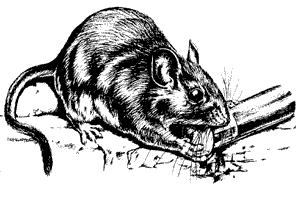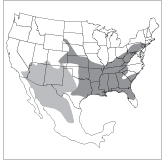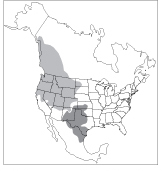|
Woodrats | Woodrat Overview | Woodrat Damage Assessment | Woodrat Damage Management | Woodrat Resources | Woodrat Acknowledgments | ICWDM | Wildlife Species Information |

Figure 1. Wood rat (genus Neotoma)
Contents |
Identification
Eight species of woodrats (genus Neotoma) occur in North America (see below). Locally known as pack rats or trade rats, these rodents are about the size of the common Norway rat. They are distinguishable from Norway rats by their hairy rather than scaly tail, soft, fine fur, and large ears. They usually have light-colored feet and bellies.
General Biology, Reproduction, and Behavior
Woodrats climb readily and are usually active at night. Most species build a large stick den or house on the ground or in trees, but some species live in rocky outcroppings. These houses are typically occupied by one individual or by a female and her young. One animal may inhabit several houses. A nest, usually made of finely shredded plant material, is located within the larger house. Breeding usually occurs in the spring. Woodrats produce 1 to 4 young per litter and may produce more than 1 litter per year in the southern parts of the United States.
Habitat
Each species of woodrat is generally restricted to a given type of habitat within its range. Woodrats occur from low, hot, dry deserts to cold, rocky slopes above timberline (Table 1).
- Woodrats (Neotoma spp.) in North America.
Species: Eastern woodrat (Neotoma floridana)
Description: Total length 14 to 17 inches (36 to 43 cm). Large grayish-brown woodrat with white or grayish belly. Tail shorter than head and body.
Habitat Preference: Rocky cliffs and mountain regions. Usually builds a home of sticks and debris.
Food Preference: Seeds, nuts, and fruits.
Species: Southern plains woodrat (Neotoma micropus)
Description: Total length 13 to 14 inches (33 to 36 cm). Steel-gray woodrat with white hairs on throat, breast, and feet. Blackish tail.
Habitat Preference: Semi-arid brushland, low valleys, and plains.
Food Preference: Cactus, seeds, and acorns.
Species: Whitethroat woodrat (Neotoma albigula)
Description: Total length 13 to 15 inches (33 to 38 cm). Body is gray, belly is white. Hairs on throat and feet white. Tail whitish to brown.
Habitat Preference: Brushlands and rocky cliffs with shallow caves. Builds a house 2 to 3 feet
(0.6 to 0.9 m) high made of sticks and rocks.
Food Preference: Cactus, beans and seeds, leaves of plants, especially new growth.
Species: Desert woodrat (Neotoma lepida)
Description: Total length 10 to 13 inches (25 to 33 cm). Body pale to dark gray washed with fulvous. Belly grayish to fulvous. Slate gray at base of hairs.
Habitat Preference: Desert floors or rocky slopes. House usually on ground or along cliffs.
Food Preference: Seeds, fruits, acorns, and cactus.
Species: Stephens woodrat (Neotoma stephensi)
Description: Total length 10 to 14 inches (25 to 36 cm). Body grayish buff, darker on top, belly washed with buff. Dusky wedge on top hind foot. Tail slightly bushy on end, whitish below, blackish above.
Habitat Preference: Juniper woodlands.
Food Preference: Primarily juniper.
Species: Mexican woodrat (Neotoma mexicana)
Description: Total length 12 to 13 inches (30 to 33 cm). Gray to black in color. Tail distinctly bicolored with white below, black above.
Habitat Preference: Rocks and cliffs in mountains. Does not normally build houses.
Food Preference: Acorns, nuts, seeds, fruits, and cactus plants.
Species: Dusky-footed woodrat (Neotoma fuscipes)
Description: Total length 14 to 18 inches (36 to 46 cm). Body gray-brown above, gray to white below. Tail slightly paler below. Dusky hairs sprinkled on hind feet.
Habitat Preference: Dense chaparral, riparian thickets, deciduous or mixed woodlands. Builds large stick houses on ground or in trees.
Food Preference: Variety of seeds, nuts, acorns, fruits, green vegetation, and fungi.
Species: Bushytail woodrat (Neotoma cinera)
Description: Total length 15 to 16 inches (38 to 41 cm). Body varies from pale gray to nearly black. Has a long, bushy squirrel-like tail.
Habitat Preference: High mountains. Climbs about cliffs easily. Does not normally build houses.
Food Preference: Green vegetation, twigs, and shoots. Feed outside. Trails 3 to 4 inches (8 to 10 cm) wide from the building to the outside may be visible.
|
Woodrats | Woodrat Overview | Woodrat Damage Assessment | Woodrat Damage Management | Woodrat Resources | Woodrat Acknowledgments | ICWDM | Wildlife Species Information |
Range
The ranges occupied by woodrats are shown in figures 2, 3, 4, and 5.
Figure 2. Range of the eastern (dark) and whitethroat woodrats (light) in North America. Figure 3. Range of the southern plains (dark) and bushytail woodrats (light) in North America.


Figure 4. Range of the Mexican (dark) and desert woodrats (light) in North America. Figure 5. Range of the dusky-footed (dark) and Stephens woodrats (light) in North America.


Food Habits
The food habits of woodrats are relatively specific for the individual species. Species such as the bushytail woodrat, for example, feed primarily on green vegetation, twigs, and shoots, whereas the Mexican woodrat feeds on seeds, fruits, acorns, and cactus (Table 1). Woodrats may also be attracted to human food supplies in buildings. When nesting inside buildings, woodrats usually continue to feed outside. Trails 3 to 4 inches (8 to 10 cm) wide from the building to the outside may be visible.
Terrell P. Salmon. Wildlife Extension Specialist . Department of Wildlife, Fisheries and Conservation Biology. University of California. Davis, California 95616
W. Paul Gorenzel. Staff Research Associate, Department of Wildlife, Fisheries and Conservation Biology. University of California, Davis, California 95616
